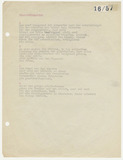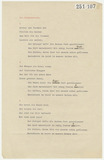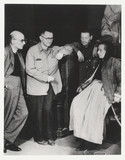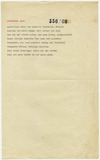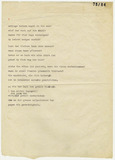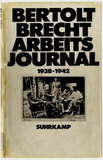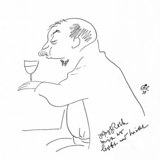Bertolt Brecht: Five Difficulties in Writing the Truth, covert text (1935)
Bertolt Brecht’s treatise Five Difficulties in Writing the Truth was published in April 1935 in the journal Unsere Zeit which appeared in Paris, Basel and Prague. One part of the edition was distributed in Germany as a covert text under the title Statute of the Reich Association of German Writers, the approved writers’ association in Germany.
Bertolt Brecht: Hollywood Elegies, typescript (1942)
Brecht writes songs about the dream factoryThe writer Bertolt Brecht saw life in Hollywood as one dominated by consumer goods and money. He had never experienced capitalism, which he fought against in Germany, in this form before.
Bertolt Brecht: Kaelbermarsch [March of the Calves], typescript (1943)
The lyricist Bertolt Brecht wrote the satirical song Kälbermarsch [March of the Calves] in September 1933, during his French exile. Later, Brecht incorporated it into his play Schweyk im Zweiten Weltkrieg [Schweyk in the Second World War], which he wrote between 1941 and 1944.
Bertolt Brecht: Mutter Courage und ihre Kinder
First rehearsals after returning from exile (1948)Erich Engel and Bertolt Brecht co-directed Brecht's drama Mother Courage and Her Children from November 1948 to January 1949 in Berlin. Helene Weigel took the lead role.
Bertolt Brecht: Svendborg, typescript (1938)
This poem comes from the collection, The Svenborg Poems, by writer Bertolt Brecht, which was published in Copenhagen in June 1939 under the title Poems in Exile. Besides observations concerning the political situation in Germany following the Nazi seizure of power, there are repeated references to his life on the run in Denmark, to the landscape and the house “under the Danish thatched roof”, in which he lived from 1933 to 1939 and which became a meeting place for many of his friends.
Bertolt Brecht: Thoughts About the Duration of Exile, typescript (1937)
The writer Bertolt Brecht wrote the poem Thoughts About the Duration of Exile in 1937 in the Danish town of Svendborg. Brecht by no means chose this place of exile by chance.
Bertolt Brecht: Work diary, 1938-1942 (1973)
The writer Bertolt Brecht was a tireless diarist. In addition to his private diaries, he also kept a work diary, which his wife Helene Weigel later designated his Arbeitsjournal [work diary].
Bil Spira: caricature of Joseph Roth (1939)
“Wie er leibt und trinkt” [A passionate drinker]The illustrator Bil Spira (Wilhelm Spira), who had worked for the Vienna Arbeiter Zeitung, escaped to Paris in August 1938 after being interned in Vienna's Gestapo prison in Karajangasse and worked in Paris under the pseudonym Willi Freier.Joseph Roth and Spira met one another in the Café Le Tournon, Roth's regular café, during their period of exile in Paris.
Bil Spira: Caricature of Joseph Roth (1939)
“[…] I am the last heir of this moustache. J.R.” This is Bil Spira’s (Wilhelm Spira) recollection of his encounter with writer Joseph Roth. They met each other in exile in Paris and met up a number of times in Roth’s local, the Café Tournon.
Bill from the Hotel Splendide in Marseille for Walter Mehring (1940)
After the invasion by the German Armed Forces in Belgium, Holland and France, like countless other refugees, Walter Mehring rescued himself by escaping to the unoccupied zone in the south of France and came to the crowded city of Marseille after several weeks of being on the run.


